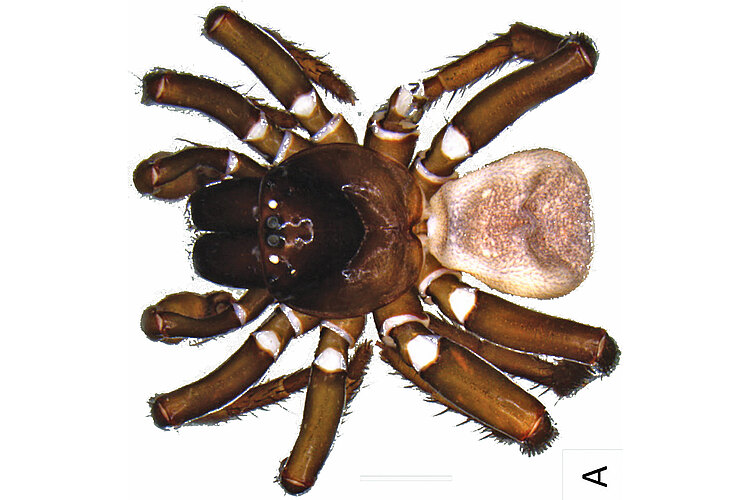Harewood's Mouse Spider Missulena harewoodi Framenau & Harms, 2017
Fauna Portal species: 7631Diagnosis
(after Framanau & Harms 2017): The colouration of the holotype of M. harewoodi is most similar to M. pruinosa due to the light dorsal discolouration of the abdomen, but the species differs in the lower number of spines of the rastellum (three vs ten), smaller size (male body length 8.0 mm vs 12.5 mm) and narrower pedipalp tibia. Male Missulena bradleyi also have a light pattern on the dorsal side of the abdo men, but it is restricted to an anterior light blue patch and the species is also larger (male body length 8.0 mm vs 10.9 mm). Otherwise, somatic morphology most closely resembles three species with a brown carapace, M. melissae, M. faulderi and M. rutraspina, but M. harewoodi differs considerably in the colour pattern of the abdomen of both live and preserved specimens (brown in M. melissae, grey-brown in M. faulderi and blue-grey in M. rutraspina) and the much smoother carapace.
Status
- native
Linnean Holotype
Australia
- Western Australia
Fauna Portal Records
The map shows all records that have been verified as part of the Fauna Portal project and may not represent the true distribution of a species. Specifically, for described species, check the link to the Atlas of Living Australia on this page for potential wider distributions. Fauna Portal Reference specimens and Linnean types are shown in red. If you identified a specimen that exceeds the distribution of an undescribed species as illustrated here, please contact the Fauna Portal team who can assist with the lodgement of the specimen in a public institution and display on the map.
Publications
TAAAGATATTGGAACAATGTATTTGATTTTTGGTGTTTGGTCTGCTATATTAGGGACGGCTATGAGAGTAATTATTCGGACTGAGTTGGGTCAGGTTGGTAGACTTTTAGGAGATGAACATTTGTATAATGTTATTGTAACTGCTCATGCTTTAGTAATGATTTTTTTTATAGTTATACCTATTATGATTGGGGGGTTTGGTAATTGATTAGTTCCTTTGATGTTAGGAGCTCCTGATATAGCTTTTCCTCGAATGAATAATTTGAGATTTTGGCTTTTACCCCCATCTCTATTTATATTATTGTTGTCGTCAGTAATTGATAGAGGCGTAGGGGCTGGGTGAACAATTTATCCTCCATTATCTTCGAGATTGGGTCATAGAGGAGGAGGAATGGATATTGCTATTTTTTCTTTGCATTTGGCAGGGGCTTCTTCTATTATGGGAGCGATTAATTTTATTTCTACTATTGTTAATATACGGGTGAGTGGAATGACAATAGAGAGGGTGACGTTATTTGTATGATCGGTGTTGGTTACTGCTATTTTGTTATTATTATCATTACCTGTATTGGCTGGGGCTGTTACTATATTATTGACTGATCGTAATTTTAATACTACTTTTTTTGATCCTGCTGGGGGAGGGGATCCAGTGTTGTTTCAGCACTTAT
Araneae (Spiders)
- Actinopodidae
- Anamidae
- Araneae fam. indet.
- Araneidae
- Archaeidae
- Argyronetidae
- Arkyidae
- Barychelidae
- Cheiracanthiidae
- Clubionidae
- Corinnidae
- Cycloctenidae
- Deinopidae
- Desidae
- Dictynidae
- Filistatidae
- Gnaphosidae
- Halonoproctidae
- Hersiliidae
- Idiopidae
- Lamponidae
- Linyphiidae
- Lycosidae
- Mimetidae
- Miturgidae
- Mysmenidae
- Nicodamidae
- Oecobiidae
- Oonopidae
- Oxyopidae
- Philodromidae
- Pholcidae
- Pisauridae
- Prodidomidae
- Salticidae
- Scytodidae
- Segestriidae
- Selenopidae
- Sparassidae
- Symphytognathidae
- Tetrablemmidae
- Tetragnathidae
- Theridiidae
- Thomisidae
- Trachelidae
- Trachycosmidae
- Trochanteriidae
- Uloboridae
- Zodariidae
- Zoropsidae
All classes
- Arachnida
- Crustacea
- Entognatha
- Gastropoda
- Insecta
- Orthoptera - Caelifera (Grasshoppers)
- Hymenoptera excl. Formicidae (bees and wasps)
- Blattodea s. str. (Cockroaches)
- Coleoptera (Beetles)
- Dermaptera (earwigs)
- Diptera (flies, mosquitos)
- Entomobryomorpha (slender springtails)
- Hemiptera - Heteroptera (True Bugs)
- Hemiptera - Sternorrhyncha (aphids, scales etc.)
- Hemiptera - Auchenorrhyncha (cicadas, planthoppers)
- Hymenoptera - Formicidae (Ants)
- Trichoptera (Caddisflies)
- Zygentoma (silverfish)
- Myriapoda

